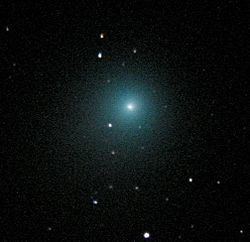Alternativedesignations Comet Machholz Semi-major axis ~537 AU Discovered 27 August 2004 | Discovery date 2004 Aphelion ~1070 AU Orbital period 113,465 years Inclination 38.6° Last perihelion 24 January 2005 | |
 | ||
Epoch 2453415.5 (February 14, 2005) Similar 96P/Machholz, C/2001 Q4 (NEAT), 153P/Ikeya–Zhang, C/1911 O1, Comet Pojmański | ||
Comet machholz july solar satellites
Comet Machholz, formally designated C/2004 Q2, is a long-period comet discovered by Donald Machholz on August 27, 2004.
Contents
It reached naked eye brightness in January 2005. Unusual for such a relatively bright comet, its perihelion was farther from the Sun than the Earth's orbit.
Nibiru is comet machholz skyview challenge
Period
Given the orbital eccentricity of this object, different epochs can generate quite different heliocentric unperturbed two-body best-fit solutions to the aphelion distance (maximum distance) of this object. For objects at such high eccentricity, the Suns barycentric coordinates are more stable than heliocentric coordinates. Using JPL Horizons the barycentric orbital elements for epoch 2011-Jan-01 generate a semi-major axis of 537 AU and a period of approximately 12,500 years. This gives it a barycentric orbital period just a little larger than Sedna.
